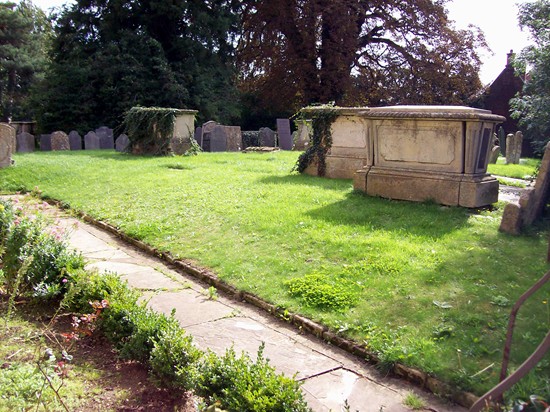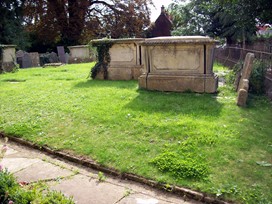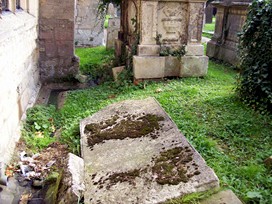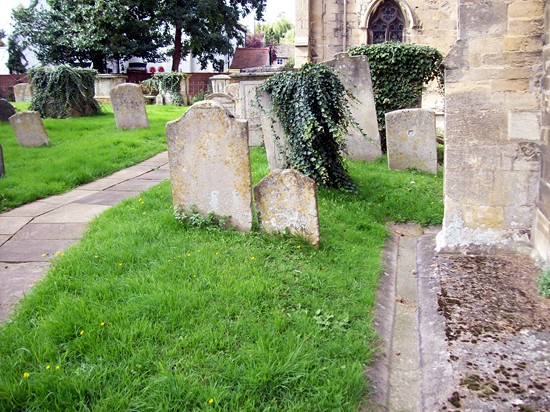|
Burials in the
churchyard
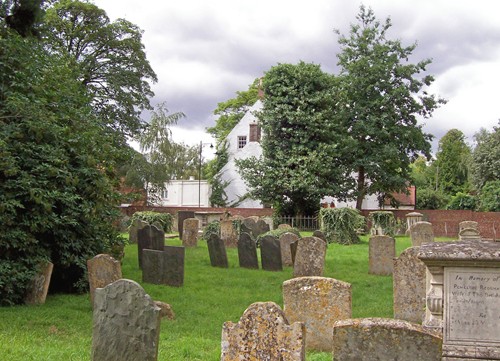
The churchyard is regarded
as the last resting place of those who went before and has become the
focal point of research for anyone anxious to trace ancestors from past
centuries.
This plot of secluded land to the south of the Abbey Church, shaded by
ancient chestnuts and lined with slate and granite tombstones, contains
barely 300 graves yet those who died in Bourne in past centuries are
numbered in their thousands and leaving us with the mystery of where they
were all buried.
Graveyards were usually established at the same time as the building of
the church which in this case is 1138, and were often used by those
families who could not afford to be buried inside the place of worship
itself. The nobility and those who were wealthy and important, usually
landowners, were given crypts or space beneath the chancel and the nave
and several ledger stones in the Abbey Church mark such graves, notably
Alice Hyde (1685-1737), John Hurn (1688-1757) and Hargate Dove
(1744-1810).
Most people from the middle or working classes were buried outside in the
churchyard, usually divided by social status, and families of the deceased
who could afford the work of a mason marked the grave with a headstone but
most could not although sometimes a religious symbol made from wood was
placed on the grave and as this quickly deteriorated in extreme weather
conditions, the graves eventually became unmarked. There were also
favourable locations according to who you were and as the entire
churchyard was not always consecrated ground, a practice persisted until
the 19th century whereby the virtuous were buried on the south side of the
church which received the most sunshine while felons, outcasts and
unbaptised infants were consigned to the perpetual shadow of the north
side.
By the mid-19th century, burials ended in the churchyard at Bourne
because, like many others around the country, it was deemed to be full.
There was no more space and some plots had been used two, three and even
four times for interments with bodies stacked one upon the other, a
situation which resulted in the opening of the town cemetery in 1855.
There were several different types of graves then in use, the private
grave on a specific plot of ground purchased by a person with the right to
erect a headstone or other monument, a common grave filled by several
unrelated persons who had died during a specific period but could only
afford the basic burial, a public grave several tiers deep but filled up
after each interment and a pauper’s grave paid for from public funds but
actually an unofficial form of the common grave and usually containing
several burials.
Other variations included an inscription grave which was a type of common
grave but sometimes had a headstone serving several plots for unrelated
deaths. We should remember however, that gravestones were a 17th century
innovation while most date from the 18th century or later and so for the
first 500 years of its life, the churchyard was filled with unmarked
graves. But a close inspection of the parish registers reveals that the
number of burials recorded over the centuries could never have been
accommodated in the churchyard alone even adopting such extreme measures
as the multiple use of grave spaces.
Overcrowding was evident well before records of burials began, even as
early as the 14th century when the high number of deaths during major
outbreaks of the Black Death reached unmanageable proportions. In 1349,
for instance, when the bishops were called upon to licence new churchyards
and extensions to the old, Bishop John Gwynell of Lincoln, while
dedicating a new churchyard at Great Easton in Leicestershire to
supplement that at the mother church at Bringhurst, told the people:
“There increases among you, as in other places of our diocese, a mortality
of men such as has not been seen or heard aforetime from the beginning of
the world so that the old graveyard at your church [at Bringhurst] is not
sufficient to receive the bodies of the dead.”
The earliest records of burials can be traced back to the mid-16th
century. There were 45 burials in 1562 and this figure had risen to 64 in
1600 with subsequent years showing a slow but steady increase. The
greatest number of burials in the 17th century was between 1633 and 1642
when there was a high rate of mortality in the town believed to have been
caused by the plague which was constantly breaking out in England from the
time of the Black Death to the Fire of London. A total of 662 burials are
recorded for that ten year period, the highest annual figures being 100 in
1634 and 126 in 1638.
An estimate for the long term can be assessed from the total figure for
the first half of the 17th century when 2,670 burials were recorded for
the years from 1601-1650. Replicating this summary would mean that the
churchyard had to cope with at least 5,000 burials for each of the
subsequent centuries although the death rate was increasing with the
rising population and so between 1562 and 1855 when the churchyard closed,
at least 30,000 burials would have taken place although with unrecorded
deaths prior to that, and in those years when no register was kept, this
figure will be much higher. Cremation is not a factor because this
practice was not introduced until 1902.
These figures are borne out by the National Burials Index (NBI) which
records a total of 37,624 burials in Bourne between 1754 and 1995 although
8,287 of these were in the cemetery which opened in 1855 and so the total
for the churchyard for that period will be 29,337. My own records go back
a further two centuries to include those burials between 1562 and 1753 and
so we are able to give a continuous total over five centuries of 50,000.

Extract from the Bourne burial register for 1651
A survey of the monumental inscriptions in
the churchyard by the Lincolnshire Family History Society (Bourne branch)
in 2010, revealed that there were 276 burials at the present time and the
earliest date appears to be 1710. Using the figure of 300 graves as a yardstick
therefore, this means that the churchyard must have been used 166 times over to provide space
for the departed in the 900 years of its existence which is quite unlikely
and so there must be another explanation, perhaps that mass graves were a
far more frequent occurrence than is recorded in our church histories.
They are still used in time of war, plague and disaster and it is the
simplest solution for any authority when faced with a large number of
bodies needing burial. There are many instances of this during times of
plague and epidemic, particularly during the Black Death period and with
frequent influenza and cholera outbreaks, when alternative mass burial
pits were dug well away from inhabited areas for fear of infection,
perhaps even out in the countryside, and this will account for many
discoveries of mass graves made when farming, building and other
modernisation projects are undertaken.
John Bland of the LFHS
thinks that even these figures may be an under estimation. “The death rate
potentially could be higher”, he said. “Non-conformists and Catholics
would have no place in the churchyard at times. Where would they have been
buried? Would their deaths even be recorded?”
He accepts the theory that the present churchyard is simply too small for
the population and has suggested that perhaps it was once much larger at
some time in the past but the only evidence of this is the marooned
tombstones on the south west side which indicate that those graves were
replaced when the footpath was built but this would not mean the loss of
many burial plots. The only other land available is to the east of the
present churchyard but there is documentary proof that this was offered to
the church in 1846 and refused and a major factor in the decision was
undoubtedly the Burial Act of 1855 which resulted in the establishment of
the cemetery in South Road, thus resolving the shortage of burial space in
the future.
Many church historians offer an explanation to the mystery by pointing out
that even in a small village of say, 250 inhabitants, several thousand
people died and were buried each century and in the average country
churchyard there are about 20,000 bodies under the soil. In some counties
such as Norfolk, the ground has even risen by as much as three feet often
giving the appearance that the church has sunk into the ground. This
explanation is apparent with the churchyard in Bourne which has also
risen above the level of the church for a height of more than 2 ft. although not quite so dramatically as others elsewhere in
the country but then this is
fen soil and the land is also liable to sink, thus reducing the impact.
The inadequacy of old records makes it impossible to trace the last
resting place of everyone who died in Bourne but this changed with the
opening of the town cemetery and all 10,000 burials that have taken place
there have been recorded for posterity. Death is an inevitable
eventuality with the annual numbers rising as the population increases and
despite the frequency of cremation which accounts for more than half of
the funerals today, even the cemetery in South Road is now running out of
space and the town council is currently negotiating to buy more land for
the future.
All burials today, however, are accurately recorded and anyone who has
been interred in the past 150 years can easily be identified through
reference to the burial register held by the town council. Seeking this
information from the period prior to that, however, can prove to be a
difficult even impossible task if we are to depend entirely on the parish
registers or what may be gleaned from the grave spaces in the churchyard
and it is unlikely that the secret of how many bodies have been buried
there over the centuries will ever be revealed.
REVISED NOVEMBER 2013
See also
Finding
space for burials in Bourne

Go to:
Main Index Villages
Index
|


